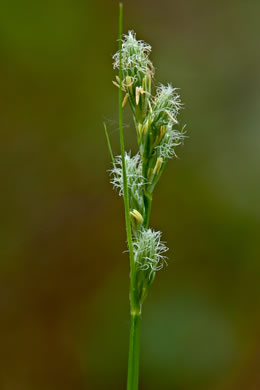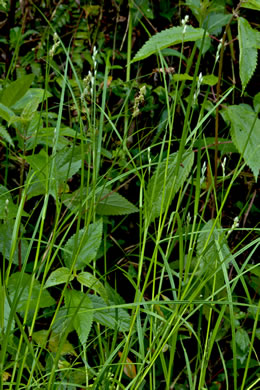Spermatophytes (seed plants): Angiosperms (flowering plants): Monocots: Commelinids: Poales
WEAKLEY'S FLORA OF THE SOUTHEASTERN US (10/20/20):
Carex longii
FAMILY
Cyperaceae
Go to FSUS key
Dig deeper at SERNEC, a consortium of southeastern herbaria.
Check out EDDMapS.org to see where this has been reported.
Read more about Long's Sedge at Vascular Plants of North Carolina.
SYNONYMOUS WITH
PLANTS NATIONAL DATABASE:
Carex longii
FAMILY
Cyperaceae
INCLUDED WITHIN VASCULAR FLORA OF THE CAROLINAS (Radford, Ahles, & Bell, 1968) 030-17-033?:
Carex albolutescens FAMILY Cyperaceae
COMMON NAME:
Long's Sedge
To see larger pictures, click or hover over the thumbnails.
Keith Bradley kab_carex_longii_73524
March Collier County FL
Fakahatchee Strand Preserve State Park
Inflorescences erect, 1-4.5cm long; spikes slightly separated to congested, per Weakley's Flora (2015).
Keith Bradley kab_carex_longii_73550
March Collier County FL
Fakahatchee Strand Preserve State Park
Stems 3-8dm tall, much exceeding leaves. Principal leaf blades 2-4mm wide, per Aquatic and Wetland Plants of Southeastern United States (Godfrey & Wooten, 1979 & 1981).
WEAKLEY'S FLORA OF THE SOUTHEASTERN US (10/20/20):
Carex longii
FAMILY
Cyperaceae
SYNONYMOUS WITH
PLANTS NATIONAL DATABASE:
Carex longii
FAMILY
Cyperaceae
INCLUDED WITHIN
VASCULAR FLORA OF THE CAROLINAS (Radford, Ahles, & Bell, 1968) 030-17-033?:
Carex albolutescens
FAMILY
Cyperaceae
If a search such as "Carex leptalea var. leptalea" doesn't deliver the results you want, try "Carex leptalea".
Or, to minimize chances of a misspelling, try just "Carex le".
Less is more: If "pencil flower" doesn't deliver the results you want, try "pencil".



